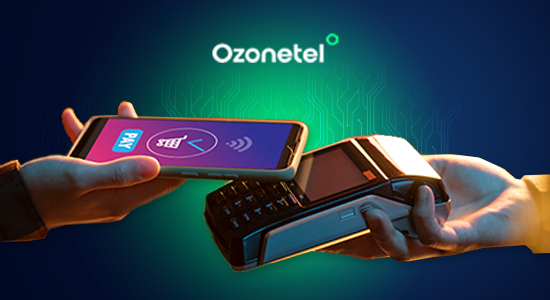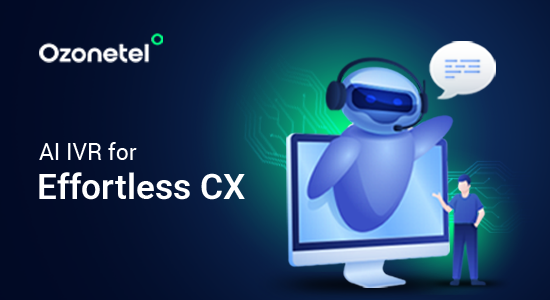- Resources
- How to Improve Call Center Productivity
How to Improve Call Center Productivity

Call center productivity is not only about answering calls or resolving issues. Instead, it’s about getting the most out of your time, resources, and technology while making sure that your team isn’t overwhelmed. When productivity levels fall, agents can feel stressed, customer satisfaction drops, and operational costs grow.
But, measuring and improving call center productivity is possible by focusing on the right areas. This includes understanding the factors that influence call center agent performance, having the right tools in place, and consistently evaluating key performance indicators (KPIs) that give insight into how well your call center is doing.
In this article, we’ll break down practical steps you can take to boost your call center productivity, from improving agent efficiency to optimizing processes that lead to higher customer satisfaction. Read along!
What is Employee Experience?
Employee Experience (EX) is the overall perception employees have of their journey within an organization. It encompasses every interaction and touchpoint, from recruitment and onboarding to daily responsibilities, support systems, and eventual offboarding.
Why Measuring Call Center Productivity is Important?

When you track call center productivity, you can pinpoint areas for improvement, optimize resources, and ensure a better experience for both agents and customers.
Below are some key reasons why it’s important to measure call center productivity:
Identify Operational Inefficiencies
When you track productivity metrics, you gain insights into how your call center agents are performing. This allows you to identify inefficiencies, such as long call times or excessive call transfers, which can increase call center operational costs. Measuring contact center productivity helps you pinpoint these issues and take corrective actions to streamline workflows, ensuring that each agent is working as efficiently as possible.
Optimize Resource Allocation
Accurate call center efficiency measurements reveal when and where your resources are needed most. For example, if your team is underperforming during certain hours, you can adjust staffing levels accordingly.
Monitoring call center efficiency also helps you avoid overstaffing (wasting resources) or understaffing (leading to delays and longer wait times) so you can allocate the right amount of resources at the right time.
Improve Customer Experience
If your call center is productive, agents can handle calls more quickly, resolve issues in fewer interactions, and decrease wait times. Moreover, customers are more likely to stay loyal to your business if they receive fast responses.
Measuring contact center productivity also allows you to spot any slowdowns that could negatively impact customer satisfaction and take steps to fix them.
Increase Agent Morale and Retention
Tracking productivity can also give you a sense of how your agents are managing their workload. If call center efficiency drops, it could be a sign that agents are overwhelmed or stressed.
Also, addressing these concerns can boost agent morale and reduce burnout. When agents feel supported and see that their work is making an impact, they are more likely to stay with your company, reducing turnover and improving overall efficiency.
Boost Cost Control
By measuring call center performance, you can ensure that agents are handling calls efficiently, reducing operational costs like overtime, unnecessary transfers, and excessive call durations. Fewer mistakes and delays also mean fewer calls need to be re-handled, ultimately lowering costs and improving your profit margins.
Track and Improve Key Performance Indicators (KPIs)
Keeping track of Call Center KPIs such as first-call resolution and call handling time helps you evaluate the effectiveness of your processes and determine if improvements are necessary. Regularly measuring and reviewing these indicators gives you the tools you need to make data-driven decisions to improve performance.
How to Measure Call Center Productivity?

By now, we’re clear on why measuring call center productivity is important, right? But how do you do this? Well, call tracking metrics gives you a clear picture of how well your team is performing and helps identify areas for improvement. Some of these include:
| Metric | Formula | Benchmark |
|---|---|---|
| Average Handle Time | Total handle time (call duration + post-call work) / Number of calls | 8-10 minutes |
| Average Call Duration | Total billable duration of all calls / Total number of calls | 6-8 minutes |
| First-Call Resolution Rate | (Number of requests resolved on a first call / Total number of calls) * 100 | 70-75% |
| Number of Agents per Hour per Call | Total number of agents on duty / Total number of calls received during that hour | 2-3 agents per 100 calls |
| Service Level | (Calls answered within target time / Total number of calls) * 100 | 80% in 20 seconds |
| Call Abandonment Rate | (Number of unanswered calls / Total number of incoming calls) * 100 | 5-8% |
| Conversation to Close Rate | (Number of successful closes / Total number of conversations) * 100 | 20-30% |
| Average Wait Time | Total wait time / Number of calls | 30-60 seconds |
| Volume and Quality of Work | Measures both the number of calls handled and the quality of interactions | Volume: 20-30 tickets/hour; Quality: 70-75% FCR |
| Customer Satisfaction Score (CSS) | Average score from customer feedback surveys (1-5 scale) | 4.0-4.5 (on a 5-point scale) |
| Net Promoter Score (NPS) | Percentage of detractors – percentage of promoters | 0-30% |
Let’s find out about these metrics in more detail.
Average Handle Time
Average Handle Time (AHT) includes the time spent on the call and any additional tasks, like follow-up work after the call ends. A lower AHT means your agents are resolving issues quickly.
However, it’s important not to compromise quality for speed. If agents are rushing through calls, it could negatively affect customer satisfaction. Balancing both speed and service quality is key.
Average Call Duration
Average Call Duration (ACD) is the average time it takes to handle a call from start to finish. Monitoring this metric helps you understand how long it takes for agents to complete their tasks.
If calls are too long, it could indicate inefficiencies in your processes or the need for better agent training. Keep an eye on average call durations to strike a balance between efficiency and quality.
First-Call Resolution Rate
The first-call resolution rate (FCR) measures how many customer issues are resolved during the first call. A high FCR indicates that your agents are effectively solving problems without customers needing to call again. And, an even higher FCR reduces repeat calls and leads to better customer satisfaction. To improve this metric, ensure that agents have the tools and training to resolve issues on the first call.
Number of Agents per Hour per Call
This metric helps you understand the number of agents needed to manage call volume. If you notice that too many agents are required to handle calls, it may indicate inefficiencies in staffing or scheduling.
On the other hand, too few agents can lead to longer wait times and abandoned calls. Call tracking metric
Service Level
Service level measures the percentage of calls answered within a specific time, typically 20-30 seconds. This metric is important because it reflects how quickly your agents are responding to customers. If service levels are low, it may indicate understaffing or poor call routing. Keeping this number high is essential for providing a positive customer experience.
Call Abandonment Rate
The call abandonment rate shows the percentage of customers who hang up before speaking with an agent. A high abandonment rate is a sign that customers are waiting too long to speak with someone, which could be due to insufficient staffing or inefficient call routing.
You can reduce abandonment by ensuring sufficient agent coverage during peak times and improving the call-routing system.
Conversation-to-Close Rate
The conversation-to-close rate tracks how many successful outcomes or sales are achieved from a conversation. If you’re running an outbound call center, this metric helps gauge how effective your agents are in closing deals.
Low performance could point to issues in agent training or the sales pitch itself. Improve this rate by offering better support, sales tools, and training to agents.
Average Wait Time
Average wait time measures how long customers wait before speaking with an agent. A high wait time can frustrate customers, leading to a poor customer experience. Reducing wait time can improve customer satisfaction and decrease the call abandonment rate. You can improve this metric by properly staffing your team during peak hours and optimizing your call routing system.
Volume and Quality of Work
This metric evaluates both the quantity and quality of the work done by agents. The volume indicates how many calls or tasks an agent handles, while the quality assesses the effectiveness of the service, which includes first-call resolution and customer satisfaction scores. Also, striking a balance between handling a high volume of calls and maintaining service quality is essential for optimal performance.
Customer Satisfaction Score (CSS)
Customer satisfaction score (CSS) is a direct measure of how satisfied your customers are with the service they receive. You can gather this information through surveys or follow-up calls. If your CSS score is low, it suggests your agents need to improve their customer interaction skills. Regular feedback helps identify weaknesses in customer service and address them promptly.
Net Promoter Score (NPS)
The net promoter score (NPS) gauges customer loyalty by asking how likely customers are to recommend your services to others. This is a valuable metric for assessing the overall customer satisfaction with your service.
Customers who score highly are promoters, while those with lower scores are considered detractors. By tracking NPS, you can gain insights into customer loyalty and potential areas for service improvement.
Reasons for Low Contact Center Productivity
Before implementing strategies to improve call center productivity, you first need to recognize factors that hinder agent performance and overall productivity. These include:
- Inadequate Training for Agents: Unstructured onboarding leaves new hires unsure of their roles while existing agents stagnate without skill development opportunities.
- Distractions in the Work Environment: Distractions like loud coworkers or malfunctioning equipment make it difficult for agents to deliver quality service.
- Outdated Technology: If technology fails or takes too long to load, agents waste time, impacting productivity.
- Inefficient Call Handling Processes: Complex or outdated call-handling processes, such as lengthy scripts or multiple systems, increase call times and reduce efficiency.
- High Turnover Rates: Frequent turnover creates a constant need for training, disrupting productivity. It also lowers team morale, as remaining agents are often burdened with additional work.
- Low Staffing Levels: Understaffing forces agents to handle more calls than they can manage, leading to burnout and decreased productivity.
- Lack of Recognition and Motivation: Without appreciation for their efforts, agents may become disengaged, which impacts performance.
- Poor Leadership Support: Without guidance or support from supervisors, agents may become disengaged or unclear on expectations.
- Ineffective Call Routing: Inefficient call routing wastes time and frustrates both agents and customers.
- Lack of Career Development Opportunities: Without room for growth, agents may become disengaged and dissatisfied with their jobs.
Tips to Boost Call Center Productivity

Now, let’s look at some actionable tips to optimize your call center productivity, supported by real-world examples from successful implementations.
Automate Repetitive Tasks
Automating routine tasks such as query handling, lead follow-ups, and call dispositions can free up agents to focus on more complex interactions. This reduces workload and improves efficiency.
For example, one of India’s leading NBFCs implemented a self-service IVR (Interactive Voice Response) system to handle basic inquiries like overdue payments and insurance queries. As a result, they automated 70% of customer queries, significantly reducing the burden on agents and achieving a 5% reduction in turnaround time (TAT).
Implement Smart Call Routing
Using advanced routing systems ensures that customer inquiries are directed to the most qualified agents. This minimizes wait times and boosts first-call resolution rates.
For example, Acko, a car insurance company, developed a predictive IVR system that preemptively routed calls based on customer data like policy duration and claim status. This improved routing accuracy by 20%, leading to faster resolutions and a 50% boost in agent productivity.
Integrate CRM Systems
Integrating call center tools with CRM (Customer Relationship Management) systems allows agents to access complete customer information instantly. This reduces handling times and improves the quality of interactions.
For instance, one of India’s leading NBFCs integrated its CRM with , enabling agents to view customer profiles and transaction histories in real time. This integration improved first-call resolution to 90% and increased agent efficiency by 10%.
Focus on Real-Time Monitoring
Real-time monitoring tools help supervisors track agent activity, identify bottlenecks, and provide immediate feedback for improvement.
For example, an NBFC company used Ozonetel’s unified dashboard to monitor agents across multiple locations. This approach streamlined performance tracking and contributed to a 5X increase in agent efficiency.
Set Up Smart Self-Service Options
Let customers solve simple problems on their own through Interactive Voice Response (IVR) systems. Program your IVR to handle common requests like account balance checks, payment status updates, or basic information queries.
For example, Redcliffe Labs, a diagnostic center, resolved 70% of customer queries through self-service IVR, which freed up their agents to handle more complex cases that needed personal attention.
Automate After-Call Work
Reduce the time agents spend on paperwork after each call. To reduce
For instance, a leading finance company cut their after-call work time from 2 minutes to 32 seconds by automating call notes and outcome recording. This allowed them to handle 10 lakh (1 million) sales calls every month, and their agents could focus more on actual customer interactions rather than documentation.
Build Local Language Support
Local language support goes beyond just translation – it includes understanding regional preferences, cultural sensitivities, and communication styles. This approach helps build trust and makes customers more comfortable sharing their concerns.
Redcliffe Labs paired callers with local representatives who spoke their dialect, leading to 2.5 times better efficiency in their healthcare advisory team. Their agents could explain medical terms and procedures more effectively in the local language, which improved customer understanding and satisfaction.
Create Priority Queues for Repeat Callers
Set up separate queues for customers who call multiple times about the same issue.
For example, Wakefit, a furniture company, created a special queue for repeat callers and saw their customer repeat rate drop from 2.7 to 2.0 calls per issue. They also used this system to proactively solve common problems, which decreased their overall call volumes by 26%.
Conclusion: How Ozonetel Can Improve Call Center Productivity
Improving call center productivity is essential for delivering exceptional customer experiences, reducing operational costs, and empowering your agents to perform at their best. With Ozonetel’s unified CX platform, you gain a reliable, scalable, and efficient solution tailored to streamline your communication processes across channels.
Why Choose Ozonetel?
- Fast Deployment: Launch a cloud contact center within 24 hours.
- Seamless Integrations: Open APIs integrate effortlessly with your CRM.
- Omnichannel Management: Handle calls, SMS, WhatsApp, and chatbot conversations on a single platform.
- Real-Time Insights: Automated quality audits and performance evaluations.
- Security and Compliance: Enterprise-grade security and global telecom compliance.
Trusted by 2,500+ businesses and powering over 2 billion calls annually, Ozonetel is the partner you need to redefine efficiency and customer satisfaction in your call center.
Ready to boost your call center’s productivity? Schedule a free demo with our team today!
Practical Ways to Improve Employee Experience
Here are some effective ways to enhance EX in today’s business environment:
1.Flexible work policies
With the rise of hybrid and remote work, offering flexibility is essential for improving work-life balance. Flexible work arrangements increase job satisfaction and reduce stress and absenteeism.
Implement policies that allow employees to choose between in-office, hybrid, or fully remote work. Flexible hours and “no-meeting” days can help employees manage their workload more effectively.
2.Comprehensive wellness programs
Supporting employees’ physical, mental, and financial wellness is crucial to their overall experience. Wellness programs have proven benefits for both employees and organizations, including reduced healthcare costs, higher engagement, and improved morale.
The wellness programs should cover fitness reimbursements, access to mental health counseling, and financial planning resources. Regular wellness check-ins and personalized wellness plans can further enhance participation.
3.Career development opportunities
Investing in career development is a powerful way to show employees that you value their growth. Opportunities for upskilling, training, and clear career paths can increase motivation, loyalty, and productivity.
Provide access to mentorship programs, role-specific training, and certification courses that align with employees’ career aspirations. Offering clear progression paths and regular career development check-ins can reinforce the commitment to growth.
4.Supportive work environment
Fostering a supportive, inclusive workplace culture helps employees feel respected, connected, and valued. Inclusivity initiatives, employee resource groups, and mentorship programs enable diverse voices to be heard and celebrated.
Have employee resource groups (ERGs) that provide a safe space for different employee communities, from cultural and gender diversity to mental health support.
Technology to Implement Employee Experience
Apart from these tips, implementing the right technologies can significantly improve how employees interact with their workplace, which can promote a positive and productive environment. Here are some technology that you can implement:
Human Resource Management System (HRMS)
An HRMS can streamline various administrative tasks by integrating with:
- Time and attendance systems.
- Payroll management software.
- Single sign-on (SSO) for easier access.
This minimizes micromanagement, supports self-service capabilities, and enhances the workplace experience.
Self-Service Portal
Offer an employee self-service portal where team members can:
- Access and update their personal information.
- Review benefits and request time off.
- Find important company policies without needing HR’s assistance.
Virtual Platforms
Strengthen teamwork with collaboration tools like Microsoft Teams, Slack, or Trello. These platforms make it easy for employees to communicate, manage projects, and stay connected—whether working remotely or across departments.
Chatbots
Chatbots use natural language processing (NLP, a type of AI that helps computers understand and respond to human language) to provide quick and accurate assistance.
And AI-enabled HR chatbots can simplify common HR tasks, such as:
- Answering frequently asked questions.
- Offering real-time support for employee queries.
Mobile App
A mobile app keeps employees connected and informed, offering easy access to company updates, news, and resources. This is particularly useful for remote or on-the-go employees, ensuring they stay engaged and up to date with what’s happening within the company.
Performance Management System
A performance management system helps track goals, provide feedback, and recognize achievements. Combining this with people analytics—tools that analyze employee data—can give you insights into performance trends and areas where improvements can be made. This not only boosts productivity but also ensures that employees feel valued and motivated.
Learning Management System (LMS)
Talent development is key to improving employee experience. A learning management system (LMS) offers employees easy access to training and development resources, helping them stay compliant and grow in their roles.
AI-powered features can even identify skill gaps and recommend personalized learning paths, ensuring that your employees have the resources they need to succeed.
Real-World Examples of Exceptional EX
Now, let’s look at some real-world examples that show how organizations are fostering environments where employees can thrive, with a focus on personal growth, open communication, and adaptability.
Cisco
Cisco fosters exceptional employee experiences (EX) by prioritizing self-directed learning, career development, and performance management. The company invests in employee growth through training, with an average of 8.6 hours spent on learning per full-time employee in fiscal 2023.
Moreover, Cisco empowers employees to explore different roles and develop new skills, while also ensuring teams are aligned and supported through regular feedback and agile performance management.
Microsoft
The company uses Microsoft Viva Insights to provide personalized recommendations that help employees improve their work habits, manage stress, and achieve better work-life balance. This platform also supports managers by offering data-driven insights to improve team dynamics and leadership practices.
As “Customer Zero” for its own products, Microsoft collaborates closely with the Viva Insights team, using internal feedback to refine features and ensure the tool meets employee needs. With a focus on privacy, inclusion, and adaptability, Microsoft is creating a thriving, engaged workforce through data-backed solutions and continuous improvement.
Salesforce
With 94% of employees willing to go the extra mile and 92% feeling productive in a flexible environment, Salesforce’s approach is clearly effective. The company also established an EX team dedicated to enhancing employee engagement by using data to address challenges and support employees in balancing work and personal life. This focus on connection, flexibility, and data-driven improvements has helped Salesforce create a thriving, inclusive workforce.
Alphabet Inc., the parent company of Google, is a prime example of exceptional employee experience (EX). Known for its innovative workplace policies, the company prioritizes employee well-being by offering flexible schedules, mental health support, and generous parental leave for its US-based employees. These benefits help foster a strong work-life balance, supporting both personal and professional growth.
NVIDIA
NVIDIA supports professional growth with robust training programs, workshops, and mentoring opportunities, ensuring employees have clear paths for career advancement. The company also promotes a culture of innovation through initiatives like the NVIDIA Inception Program and maintains an inclusive environment with Employee Resource Groups (ERGs).
Additionally, NVIDIA prioritizes employee well-being with comprehensive health benefits, mental health support, and flexible work arrangements, creating a supportive and balanced workplace for its employees.
How Ozonetel Helps Improve EX
With Ozonetel, you can empower your employees to manage high call volumes, address customer needs effectively, and maintain productivity, whether they work on-site or remotely. Here’s how Ozonetel helps enhance employee experience across industries:
Monitoring Call Quality Boosting Agent Productivity & Prioritizing High-Intent Leads
Ozonetel’s advanced tools for call quality monitoring and intelligent lead prioritization ensure that your agents stay productive while maintaining high customer satisfaction. For example, a stockbroking company partnered with Ozonetel to help with the fluctuating call volumes. The result?
- 40,000+ calls handled daily with up to 1,340 calls managed concurrently
- 80% First Contact Resolution (FCR)
- 25% reduction in average handle time (AHT)
- Advanced Tools to Facilitate Remote Working Stockbroking
Apart from managing call volumes, Ozonetel provides you with tools like real-time dashboards and remote agent features that allow supervisors to maintain productivity effortlessly.
For example, a leading stockbroking firm transitioned to a fully virtual contact center ensuring uninterrupted service with Ozonetel’s platform. The result?
- 650+ agents managed remotely, handling over 1 lakh minutes of calls daily.
- 60% increase in CSAT (Customer Satisfaction Score)
- 40% reduction in agent attrition
Improve the Performance of 900+ Healthcare Advisors
For large-scale initiatives like PM-JAY, managing the performance of healthcare advisors while ensuring beneficiary satisfaction requires advanced analytics and monitoring. Ozonetel’s AI-based tools simplify supervision and enhance advisor performance. The results?
- 900 advisors monitored daily using AI-driven speech analytics.
- 122,000+ hours of conversations analyzed across 11 vernacular languages.
- 30 hours saved per supervisor per month through automated quality audits.
Conclusion
When EX is strong, employees are engaged, motivated, and less likely to leave, which means less turnover, more productivity, and a culture people want to be part of. Leaders who invest in EX aren’t just keeping up with trends; they’re actively setting their companies up for a competitive edge in attracting and keeping top talent.
Take a close look at your current EX. Where are the gaps? What could be done better? Small improvements today can create a lasting impact tomorrow. A positive employee experience doesn’t just improve work for your team—it drives real results that lift the whole organization. So, let’s get moving on building an EX that truly shines.
Start your EX journey today by conducting employee surveys, implementing flexible work arrangements, and investing in employee development.
Want to see what Ozonetel can do for your company? Sign up today for a free 7-day trial.
Prashanth Kancherla
Chief Operating Officer, Ozonetel Communications
Over the past decade, Prashanth has worked with 3000+ customer experience and contact center leaders...
Chief Operating Officer, Ozonetel Communications
Over the past decade, Prashanth has worked with 3000+ customer experience and contact center leaders to comprehensively understand the need for effective and efficient customer communications at every step of their journey with a brand. Deeply embedded in today’s CCaaS ecosystem, he has been instrumental in Ozonetel's growth and contributed in various roles including product management, sales, and solution architecture.
Frequently Asked Questions
Call center productivity refers to how efficiently your agents handle customer inquiries, resolve issues, and manage interactions while balancing operational costs and maintaining high customer satisfaction. High productivity means your team is achieving more with fewer resources without compromising quality.
You can measure call center productivity by tracking key metrics and analyzing them regularly. Some common KPIs include:
- Calls Handled Per Agent: The number of calls successfully managed by each agent.
- Abandonment Rate: The percentage of calls where customers hang up before reaching an agent.
- CSAT Scores: Customer satisfaction ratings collected through post-call surveys.
- Net Promoter Score (NPS): Measures the likelihood of customers recommending your services.
- Call Quality: Evaluates how well agents communicate, resolve issues, and follow protocols.







